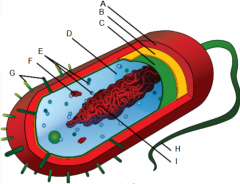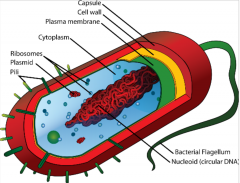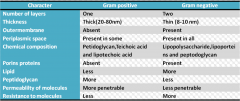![]()
![]()
![]()
Use LEFT and RIGHT arrow keys to navigate between flashcards;
Use UP and DOWN arrow keys to flip the card;
H to show hint;
A reads text to speech;
20 Cards in this Set
- Front
- Back
|
List 8 distinguishing features about prokaryotes |
-single-celled -double-stranded circular DNA -nucleoid instead of nucleus (resembling nucleus but lacking membrane) -extrachromosomal genetic material exists as plasmids (important forhorizontal gene transfer e.g, antibacterial resistance -heavily dependent on ribosome – subsequent target of mostantibiotics -no cytoskeleton -cell wall |
|

|

|
|
|
Give 8 differences between Gram -ve and +ve bacteria |

|
|
|
What is the function of the following; flagella pili glycocalyx cell wall cytoplasmic membrane |
flagella: motility pili: used for adhesion – either to other bacteria (conjugation) or tohost cell. Also offer some resistance to phagocytes. glycocalyx: eithera capsule (more dense, closely associated), or slime layer (morediffuse, less resilient). Prevents dessication, offers degree of protection from phagocytes, acts asnutrient store, and has a role in adhesion. cell wall: provides rigidity and shape and prtects from osmotic lysis cytoplasmic membrane: selectively permeable membrane and site of metabolism |
|
|
State 3 different shapes of bacteria |
coccus: round baccili: rod spirochete: spiral |
|
|
State 7 different infection routes |
-inhalation of droplets -ingestion (contaminated food and water) -transmission from infected host -insect vectors -fomite (non-living) -mucous membranes -transplacental |
|
|
Give an overview of bacterial cell replication |
-begins at origin of replication -DNA helicase unwinds, topoisomerase regulates winding to relievetension -DNA primase adds primer -DNA polymerase adds free nucleotide triphosphates -Okazaki fragments added to the lagging strand by DNA primase and DNApolymerase -DNA ligase fuses fragments; DNA polymerase replaces primers with DNA -chromosomes are segregated to poles of the cell -central z-ring forms -membrane proteins facilitate maturation of z-ring into septum andcell divides |
|
|
Define a virus |
Obligateintracellular parasites which multiply inside living cells usingcellular synthesis machinery |
|
|
Give an overview of the structure of viruses |
-genetic material can be single or double stranded, RNA or DNA -can be linear or circular, and segmented or non-segemented -contained within a capsid made up of individual proteins (capsomers) -combination of capsid and genetic material is called nucleocapsid -viruses can be diverse: they can be enveloped or non-enveloped, andicosahedral, helical or complex (e.g. bacteriophage) |
|
|
What is the structural difference between a enveloped and non-enveloped virus? |
enveloped: capsid surrounded by lipid membrane non-enveloped: capsid not surrounded by lipid membrane |
|
|
How does the presence/lack of envelope affect the function/virulence of viruses? |
- more susceptible to environmental factors e.g. solvents, drying acidity - envelopes adds additional protection from the immune system - enveloped viruses are less able to survive is they lose their envelope, and unable to enter cells as it contains their receptors - capsid of non-enveloped viruses is more resilient outside the cell |
|
|
Give two factors that affect the specificity of viruses to hosts |
- presence/absence of receptors on host cell - presence/absence of host genes to replicate vital components |
|
|
What are the different mechanisms by which enveloped and non-enveloped viruses enter host cells? |
enveloped: - endocytosisand membrane fusion - membrane fusion non-enveloped: - translocation:passes directly through - injectione.g. phages - endocytosis(clathrin-dependent) |
|
|
What are the 5 stages of viral replication? |
1. attachment 2. penetration 3. uncoating of capsid(disassembly) 4. transcription andtranslation 5. assembly andrelease |
|
|
What enzyme do all RNA viruses need? |
RNA-dependentRNA polymerase |
|
|
How does a +ve ssRNA virus replicate |
- same orientation host mRNA - means can be used directly by RNA polymerase to translate vital proteins |
|
|
How does a -ve ssRNA virus replicate? |
- has opposite orientation to mRNA cannot be used directly to make viral proteins - complimentary +ve ssRNA is made by RNA polymerase which is then used in translation - some of the strands produced will also be used a templates to make more -ve ssRNA - |
|
|
What are retroviruses and how do they replicate? |
-+ve ssRNA viruses -reverse transcriptase produced complementary -ve ssRNA –essentially this is now DNA -the DNA is integrated into the host DNA and then viral proteins aretranscribed |
|
|
How do dsDNA viruses replicate? |
-dsDNA is integrated into host cell genome -viral DNA is replicated using host DNA polymerase -viral mRNA is produced, transferred to the cytoplasm, and hostribsomes produce viral proteins -some proteins are used as transcription factors (e.g. switch to“late” genes) |
|
|
Give three ways in which a virus can cause cellular damage |
- membrane injury causing lysis - destruction by host immune system - integration of viral genes promoting a neoplastic state e.g. HPV |

